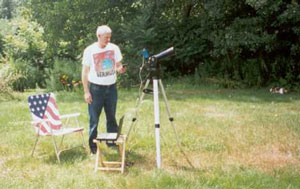
Biography
 |
Hi, I'm Ted Wilbur, thanks for visiting my web site! I live in a small town in central Massachusetts. I have a wife and two boys. I also have a cat named Mrs. Puff who sneaked into the picture above. It would have been more appropriate if she had been rubbing up against the tripod legs... My house is on a hill, I have a decent view and a nice big patch of sky to look at.
I've been at this for about 3 years now and still love it. Almost every day I check the weather in hopes of getting some scope time. Although I do enjoy observing, about 99% of my time at the scope is spent doing astrophotography. My current setup uses an LX200 with an F6.3 focal reducer as the imaging optics with an ETX90 used as a piggyback guidescope. The ETX90 has a long focal length and gives me the guiding resolution I need to get decent images through the big scope. There are few activities I enjoy more than looking up at the Milky Way on clear moonless Summer nights while the scopes and cameras do their thing.
I got my start in astronomy after being inspired by the spectacular Leonid meteor shower of 2001. I purchased a Meade ETX70 AltAz goto refractor. This is a great little telescope, fun to use, easy to setup, with a super wide field of view. Now it's my travel scope, I still use it on a regular basis. It doesn't support much magnification but it's great for the larger and brighter Deep Sky objects. I highly recommend it as a "starting out" scope for people who want to dabble without spending too much money.
I love imaging and have been steadily improving the quality of my images over time. Just about every image I have ever taken is on this site, with commentary. I don't mind sharing my good and not so good results as I learn the ropes. I have also included numerous vendor links. I am not associated with any astronomical vendors and provide the links solely to make it easier for people to get more information on the products I'm using.
My first exposure to imaging was with the Meade electronic eyepiece that was included as part of the package when I purchased the ETX70. The electronic eyepiece is not capable of long exposures, it streams frames like a video camera. It's output is black and white, and the images can be recorded on video tape or sent to a computer if you have the right hardware and software. The electronic eyepiece is very limited, but capable of taking images of the Moon, Sun, Venus, Mars, Saturn and Jupiter. I wrote an article about Imaging with the Meade Electronic Eyepiece back when I was using it.
By March 2002 I had the imaging bug bad and was looking for something a little more advanced than the electronic eyepiece. I purchased a SAC7 camera capable of taking long exposure color images. The SAC7 and the ETX70 are very well suited to each other and I took some interesting early shots with this combo. Finally in 2003 I purchased my ST8i CCD camera from SBIG. This is a great camera that I still use and am very happy with.
In July 2002 I purchased a beautiful used LX200. Nice scope but HEAVY. The LX200 purchase prompted me to design my observatory. I built it in the Fall of 2002, and the telescope(s) saw first light from it on October 27. Shortly thereafter I created this site to show it off! The LX200, guided with a piggyback ETX90 has proven to be a very capable and inexpensive setup, however it took me a good deal of time and effort to get to a point where I could get long exposures with round stars, high resolution and high signal to noise ratios. There are certainly many better mounts available, but for $2000 (the price I paid for my used LX200) this system cannot be beat, providing convenient go-to capability, a big 10 inch light grasp, and periodic error correction that enables high resolution imaging.